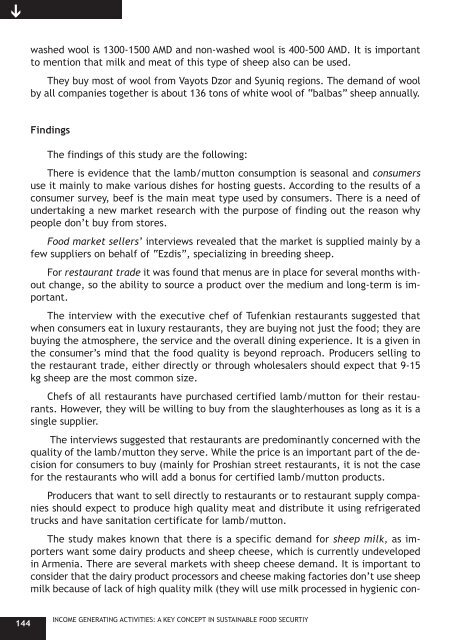Income-Generating Activities - Action Against Hunger
Income-Generating Activities - Action Against Hunger
Income-Generating Activities - Action Against Hunger
You also want an ePaper? Increase the reach of your titles
YUMPU automatically turns print PDFs into web optimized ePapers that Google loves.
➔<br />
washed wool is 1300-1500 AMD and non-washed wool is 400-500 AMD. It is important<br />
to mention that milk and meat of this type of sheep also can be used.<br />
They buy most of wool from Vayots Dzor and Syuniq regions. The demand of wool<br />
by all companies together is about 136 tons of white wool of “balbas” sheep annually.<br />
Findings<br />
The findings of this study are the following:<br />
There is evidence that the lamb/mutton consumption is seasonal and consumers<br />
use it mainly to make various dishes for hosting guests. According to the results of a<br />
consumer survey, beef is the main meat type used by consumers. There is a need of<br />
undertaking a new market research with the purpose of finding out the reason why<br />
people don’t buy from stores.<br />
Food market sellers’ interviews revealed that the market is supplied mainly by a<br />
few suppliers on behalf of “Ezdis”, specializing in breeding sheep.<br />
For restaurant trade it was found that menus are in place for several months without<br />
change, so the ability to source a product over the medium and long-term is important.<br />
The interview with the executive chef of Tufenkian restaurants suggested that<br />
when consumers eat in luxury restaurants, they are buying not just the food; they are<br />
buying the atmosphere, the service and the overall dining experience. It is a given in<br />
the consumer’s mind that the food quality is beyond reproach. Producers selling to<br />
the restaurant trade, either directly or through wholesalers should expect that 9-15<br />
kg sheep are the most common size.<br />
Chefs of all restaurants have purchased certified lamb/mutton for their restaurants.<br />
However, they will be willing to buy from the slaughterhouses as long as it is a<br />
single supplier.<br />
The interviews suggested that restaurants are predominantly concerned with the<br />
quality of the lamb/mutton they serve. While the price is an important part of the decision<br />
for consumers to buy (mainly for Proshian street restaurants, it is not the case<br />
for the restaurants who will add a bonus for certified lamb/mutton products.<br />
Producers that want to sell directly to restaurants or to restaurant supply companies<br />
should expect to produce high quality meat and distribute it using refrigerated<br />
trucks and have sanitation certificate for lamb/mutton.<br />
The study makes known that there is a specific demand for sheep milk, as importers<br />
want some dairy products and sheep cheese, which is currently undeveloped<br />
in Armenia. There are several markets with sheep cheese demand. It is important to<br />
consider that the dairy product processors and cheese making factories don’t use sheep<br />
milk because of lack of high quality milk (they will use milk processed in hygienic con-<br />
144<br />
INCOME GENERATING ACTIVITIES: A KEY CONCEPT IN SUSTAINABLE FOOD SECURTIY

















